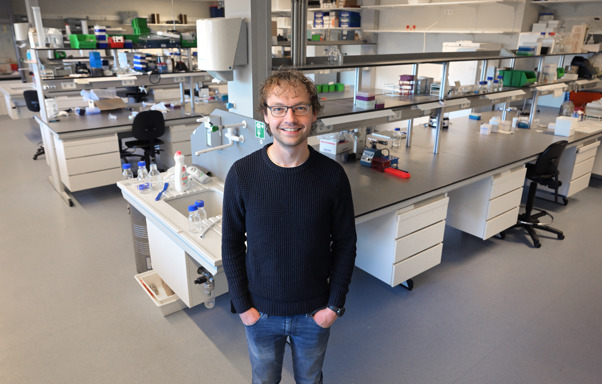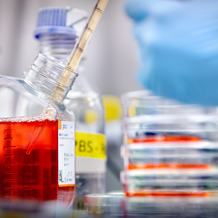New group leader gives new meaning to phrase ‘to measure is to know’
31 Jan 2023 16:00
As of February 1, biologist and science fanatic Rik Lindeboom will be reinforcing our institute as a junior group leader. He wants biologists to start using exacter measurements, and is an expert in proteins and data analysis. Only through these concrete numbers can we learn to understand why an immune cell does or doesn’t recognize a cancer cell. We joined him for a discussion on love in the lab, bizarre amounts of data, and (in)visible cancer cells.
It’s only Rik Lindeboom‘s second visit to the Netherlands Cancer Institute ever when he comes in for the interview. He is visibly excited about his new work when he walks through the central hall. His first visit wasn’t as a patient, thankfully, but as an applicant.
You’re setting up a new lab. How will you decide what to investigate?
“That was one of the most difficult decisions I had to make when it became clear that I would be working here. Since obtaining my PhD I have been carrying a notebook to write down all my ideas and research questions.” He takes a black notebook from his bag and leafs through it. “Eighteen pages...”
That sounds like a difficult challenge. What did you decide on?
“We want to investigate how the immune system recognizes cancer. Over the last few years it became possible to measure a bizarre amount of data in one single cell, which helps us understand what happens inside. Over the last two years I have been researching COVID-19 resistance this way in Cambridge. And now I will be focusing on individual cancer cells and immune cells.”
There are many scientists working on the immune response against cancer. What are you hoping to contribute?
“I want to find out, in exact numbers: how many cancer proteins does a cell need to display on its surface to reveal itself to the immune system? All our cells display proteins on their surfaces, which allows immune cells to recognize them. What makes cancer cells unique? I will use this knowledge to create computer models that can predict whether immune cells will be able to recognize cancer cells.”
Why are these exact numbers so important?
“Cancer cells share many characteristics with regular cells. It would make sense to start comparing them: a cancer cell contains five times time amount of cancer proteins found in a healthy cell. So that’s what many researchers do. But five times doesn’t mean that the difference is relevant and you can base a therapy on it. Does a cancer cell contain 50 cancer proteins, or a million?”
What is the benefit of knowing?
“It could be the case that a cell with 50 proteins on its surface remains invisible to the immune system, while a cell with a million proteins does not. That’s why you need to take measurements. It bothers me that the exact numbers often remain unknown when it concerns cancer cell characteristics.”
So I understand it’s quite rare that you will be looking into the number of proteins in and on the cells
“Yes, it’s fairly unique. And important, because we are missing a lot of data on this in science. The proteins do all the work in our body, so you want to measure the. Most scientists will measure DNA and RNA, which is easier. But we now know that this could provide a distorted image. DNA contains our genetic code and RNA is the messenger that helps translate this code into the functional proteins that operate our body. If you only measure the messengers, you measure an intermediary stage. Having a lot of messengers doesn’t always translate to a lot of proteins.”
What do you do when you’re not at work?
“I love looking after my two year old son. And science is my hobby as well as my work. When I’m on the couch I may just be found reading papers about the migratory patterns of king penguins. Oh, and I love to cook, and I want to understand what’s happening when I do. What is the effect of the pressure of a pressure cooker on the meat tissue? What happens at the molecular level when steak burns?”
‘To measure is to know’ could be your motto…
“Yes, even outside of science I like to see things substantiated by measurements. I try to measure something of anything that’s important to me. I create Excel sheets before an expensive purchase, preferably with the price tracked over time. I was quite young when I started looking into numbers and programming. In high school I created computer games and later built websites, and I created computer models at the lab, often just for fun.”
Why do you want to work at the Netherlands Cancer Institute?
“The Netherlands Cancer Institute is a really cool place. It’s a prestigious institute with strong fundamental research and a direct connection to the clinic. That appeals to me. I had never been here before – this is only my second time! My wife and I lived in Cambridge until recently, because we both did our research there.”
You’re a science couple, that can’t be a coincidence
“We both accepted a PhD position in the same group without knowing, as we found out at a party. We knew each other from our internships in that same group, after which we both went our separate ways abroad. We got together during our PhD research.”
That seems tricky, conducting your PhD research together…
“Yes, a couple that survives PhD research together, stays together! We worked closely together, but we did have different roles: she did pipetting, I did data analysis. That means that our frustrations never involved each other. We started dating after about a year. Good old days, haha.”
And now you’re looking for PhD students for your own group
“Right, two to start with. We will conduct our own experiments at the lab and analyze large data sets. We will collaborate closely with other groups, such as the one from my former supervisor, Michiel Vermeulen. He will join the NKI together with me. It will be a hectic time, setting things up. And it’s a tenure track of five years, so I will have to prove myself.”
Rik Lindeboom's research group was made possible thanks to a grant from the AVL Foundation.
 nl
nl
 Nederlands
Nederlands

